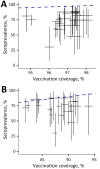Detection of Immunity Gap before Measles Outbreak, Ho Chi Minh City, Vietnam, 2024
- PMID: 41017062
- PMCID: PMC12483019
- DOI: 10.3201/eid3110.250234
Detection of Immunity Gap before Measles Outbreak, Ho Chi Minh City, Vietnam, 2024
Abstract
In 2022, we established a residual sample serosurveillance program in Ho Chi Minh City, Vietnam. During September 2022-April 2024, we found low measles antibody seroprevalence in children in the city's western region, where a measles outbreak began in May 2024. Serosurveillance could be a useful tool for outbreak prediction and prevention.
Keywords: Measles; Vietnam; disease outbreaks; epidemiology; population surveillance; serology; viruses.
Figures


References
-
- Diggle PJ. Estimating prevalence using an imperfect test. Epidemiol Res Int. 2011;2011:608719. 10.1155/2011/608719 - DOI
-
- Prem K, Zandvoort KV, Klepac P, Eggo RM, Davies NG, Cook AR, et al. ; Centre for the Mathematical Modelling of Infectious Diseases COVID-19 Working Group. Projecting contact matrices in 177 geographical regions: An update and comparison with empirical data for the COVID-19 era. PLoS Comput Biol. 2021;17:e1009098. 10.1371/journal.pcbi.1009098 - DOI - PMC - PubMed
Publication types
MeSH terms
Grants and funding
LinkOut - more resources
Full Text Sources
Medical
Miscellaneous

